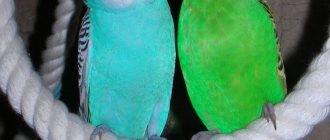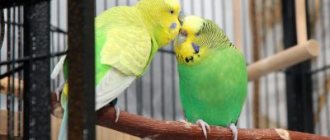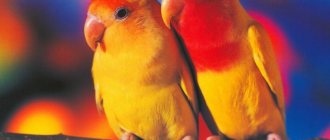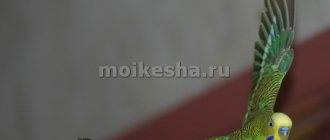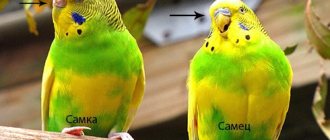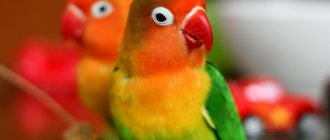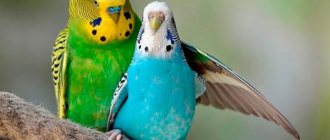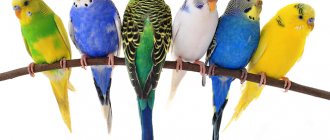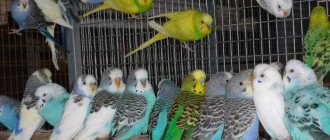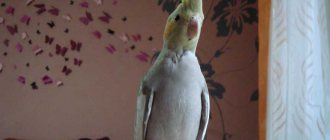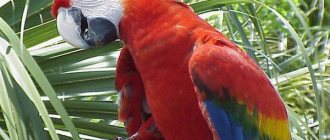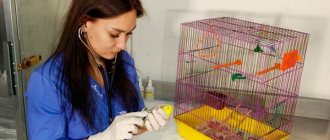Colors and shades of wax
There are several options through which you can quite accurately determine the sex of birds.
Among the simplest is the type of cere (a formation located above the beak). You can focus on the color of the wax. One of the important nuances that is worth paying attention to is that its color may change with age. Therefore, experts recommend using two directions of this method:
In chicks. In addition, the color of the wax tends to change depending on the time of day. In order to have the best possible chance of determining the sex of the bird as accurately as possible, it is recommended to observe them for several days. In order not to miss something important, it is better to take several photographs, which will make it much easier to navigate with the change in color of the growth. It is already possible to determine the sex of chicks when they reach 4–5 weeks of age.
In a female budgerigar, the color of the cere can take on all shades of pink, or be light blue or light blue. Upon careful examination of the growth, you can notice that in the female it is colored heterogeneously: directly near the nostrils, the wax is almost white without any shades.
It is possible that the growth in males will also have a purple color. In this case, in females the purple color has a bluish tint.
If the chick's cere is pink, it is recommended to pay attention to the uniformity of color, as well as the color of the growth near the nostrils.
The male has a predominant violet, lilac and pink color of the growth above the beak. Unlike the coloring in females, in males it is located evenly over the entire surface of the wax. It is rare to observe faint pale blue circles near the nostrils.
If the male has a purple growth over his beak, it has a noticeable pink tint. The easiest way to use the option of determining the sex of a budgerigar by the color of its wax is when the bird is 3 or more months old.
In adults. When the bird is more than 4 months old, there are practically no difficulties in determining the sex.
In the female budgerigar, the color of the cere gradually changes from bluish-pink to beige. With a quick glance at the wax of a mature parrot, which is beige in color, we can confidently say that it is a girl.
Throughout the life of a parrot, its beak also has the ability to change its color. This is mainly due to changes in hormonal levels: in a young bird it is purple, and with age it becomes grayish-brown.
In some cases, the female's cere may take on a tinge of blue with white circles near the nostrils on the bill.
It is worth noting that even in female budgerigars, which are classified as albino or lutino, the color of the growth above the beak changes according to the same pattern. How can you determine that this is a male budgerigar? Their cere is predominantly bright blue in color. Unlike females, male budgerigars (lutino or albino) have beaks that practically do not change color. It remains pink or blue-pink for their entire life.
Hyperkeratosis
This disease causes overgrowth of the tissues of the beak and upper beak. The owner can see dark plaques on the cornea and a bird's beak covered in whitish scales. Such changes occur as a result of a malfunction of the endocrine and genitourinary systems.
The therapy is simple: treat the tissue in the growths with retinol ointment and include foods with this substance in your diet.
On a note. Prolonged sleep will speed up recovery. In the evening, earlier than usual, the lights in the room are turned off: in the dark, the parrot will immediately fall asleep.
Genetic method
This method of determining the body of a budgerigar is mainly used at a time when the bird is actively growing feathers and down. Ideally, you can look at the chick's parents. But such an opportunity does not always arise.
Since this method is based on such an exact science as genetics, it can be considered as accurate as possible. But for the average person it is not always available.
It should be noted that the genetic method works under the following condition: when the color of the feathers on the body of a budgerigar has a certain color:
- Opaline. Birds do not have stripes along the length of their backs.
- Brown. The waves can change their color from black to brown.
- Albino. Against the background of white feathers, blue planes with a blue tint are clearly visible.
- Lyutino. The feathers have a yellow, evenly spaced color.
- Lacewing. These parrots may have yellow or white feathers with clearly visible waves of a faint brown hue. Birds generally have red or pink eyes.
- Texas Cleaner. Individuals are distinguished by blurred plumage, which becomes clearer only in the lower part of the body.
- Slate. Their plumage can vary from silver to turquoise.
Having information about the mutation of the chicks' parents, we can talk about what gender they will have. How to do this correctly? If we take type A as a basis as the color you are interested in, and type B as a different plumage color, then there are only 4 possible options:
- If the father and mother have type A plumage color, it is almost impossible to accurately determine the sex of the chicks.
- If both parents have plumage type B, chicks may be born with plumage type A - these will be females, or B - males, but the possibility that these will be girls is not excluded.
- A father with feather type A and a mother B can have chicks with type A - females and B - males.
- A father with plumage type B and a mother with plumage A can give birth to offspring whose plumage color can only be type B. These can be both females and males.
As you can see, the genetic method of determining the sex of the offspring of budgerigars cannot always give the desired result.
How to determine the cause of the disease
To make a correct diagnosis, the ornithologist may ask for some information about the pet. The owner must note all the details and symptoms that accompany the appearance of growths.
You will need the following information:
- sex and age of the bird;
- diet;
- an accurate description of the symptoms of the disease;
- a list of all additives in your pet’s diet.
Only by drawing up a complete picture of the course of the disease can one determine what kind of growth has formed on the cere and beak of a budgerigar.
Appearance of individuals
Based on the appearance of the chick, one can also conclude that it belongs to one sex or another.
For example, females have a sharp forehead and a slightly flattened back of the head. In addition, females are also distinguished by the following external characteristics:
- a small hump is clearly visible on the back;
- the stomach is visually divided into 2 halves by an even parting;
- the body has a shape resembling a ball;
- the tail is wide and disheveled;
- the paws are located far from each other.
In males, on the contrary, the back of the head is flat.
Basically, females, unlike males, are distinguished by their small body size.
Biologists are confident that the use of this method is subjective. Its use cannot be considered 100% correct and effective.
Introduction
When buying a feathered friend, a person asks a number of questions, one of which is: “How to understand what gender the desired bird is?” in order to choose the right nickname and provide proper care. In addition, many amateurs want to purchase a pair of opposite sexes to produce offspring.
Unfortunately, not all pet store sellers have sufficient information on the issue of interest. Therefore, before purchasing, it is important to familiarize yourself with the typical features of these pets. For example: it is very difficult for two females to get along in one cage, but males are quite the opposite.
There are several sex determination methods that you can use when choosing a parrot. Let's figure it out. Watching birds, you can see the distinctive features of female and male individuals.
Chick behavior
Using this method can give positive results only after the chicks have undergone their first molt. Only upon reaching this age do the chicks begin to display their first sexual behavioral behaviors. Until this time, it is not recommended to use it as the main and only one when determining the sex of budgerigars.
Females constantly chirp, making a smooth, monotonous sound. They are calm and love to watch everything and everyone. They spend most of their time sitting on a perch. They love to clean up the house. Since in the wild the females take on the responsibility of arranging the hollow, at home they also show these signs of behavior: they often and for a long time gnaw on wooden perches. The possibility of females displaying aggression cannot be ruled out. In this case, they bite very painfully. They do this not in order to scare the enemy, but in order to gain victory in the skirmish.
As for the males, they have an excellent ability to imitate the sounds they hear. Their behavior is distinguished by courage and audacity. They are rarely seen sitting quietly on a perch. They prefer to run around the cage whistling sweet songs. This is also an instinctive behavior of their own: in this way, when free, they attract females.
Using this method to determine the sex of parrot chicks requires a lot of time, patience and observation from their owners.
Corneal necrosis
Not every bird owner knows how to treat growths, changes in the shape and color of the beak in wavy birds. If neoplasms in the supracervical part are accompanied by suppuration, this is corneal necrosis. The disease destroys the beak and surrounding tissues. The consequences of the disease are the saddest.
Tissue death occurs due to disruption of their blood supply due to infection. The disease can occur after suffering from rhinitis. An accompanying symptom may be scabies.
In this case, conservative treatment is not enough. The growths and pus must be removed under general anesthesia. Then antibiotic therapy is carried out.
On a note. In case of corneal necrosis, it is forbidden to use ointments - they will only aggravate the condition.
DNA analysis
In situations where it is necessary to accurately determine the sex of a bird, the achievements of modern science can help, i.e. DNA analysis, its accuracy is 99.9%. To do this, you should contact a genetic research center, where you should provide feather samples or a cloacal swab (hormonal secretions). There are specific instructions for collecting blood and feathers from parrots, so you should not do it yourself without special preparation, so as not to harm this cute creature. The turnaround time for the test is 1-2 business days from the date the samples are received. This method is the most accurate, but it costs much more than the cost of a parrot, so it is used only when absolutely necessary.
Budgerigars fill the house with bright colors, a variety of sounds, and also bring fun, enthusiasm and a great mood to their owners.
General differences
In most cases, males are slightly larger, their tail is longer, and their plumage is brighter and richer with multi-colored tints, which is associated with the natural need to attract the attention of the opposite sex. Additionally, some fanciers claim that males have a flatter head at the top. However, these indirect signs are difficult to discern with the naked eye. In terms of male behavior, they are more active and noisy than females. Males do not feel comfortable in the hands; they actively bite, but painlessly; their bites are rather demonstrative in nature. Adult males often imitate sexual contact with the help of some objects. It’s hard not to notice how indifferent they are to their mirror image, they bully, peck at it, and can even fight. The boys chirp a lot and sing long songs. It is said that their distinguishing feature is good onomatopoeia, which makes them easier to teach to speak. But in fact, this is not true - males are simply more talkative themselves.
Females are simply not so noisy, they rarely sing, usually they only chirp, but also rarely. This is why it is believed that females are more difficult to teach to talk. Also, most often, females are slightly smaller in size and have a less colorful appearance. It is said that their head is slightly sloping at the back, and their forehead is more pointed than that of males. Female birds are less energetic. Females bite hard and painfully, resulting in bloody wounds. The most noticeable feature of girls is the ability to lay eggs, sometimes even without the participation of a partner. But as already mentioned, these indirect signs are very difficult to notice.
